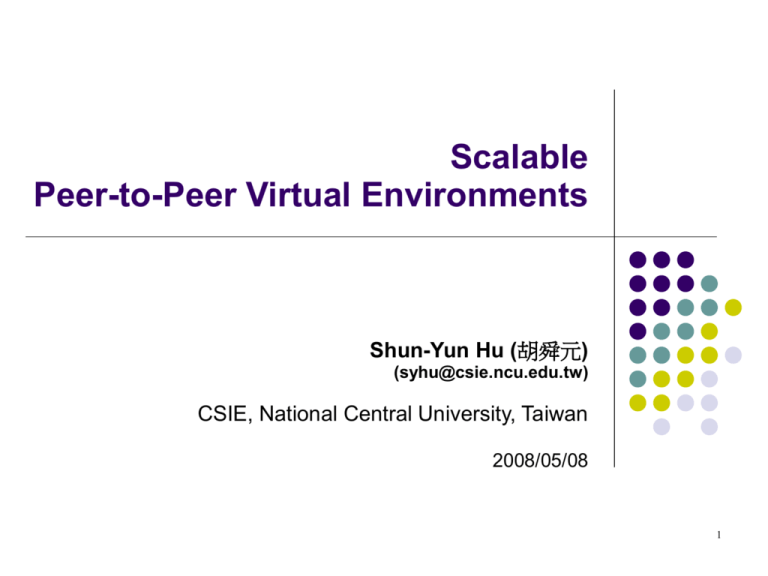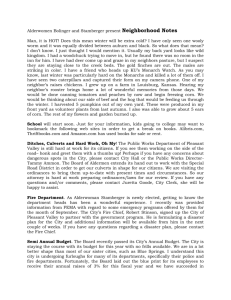ppt
advertisement

Scalable Peer-to-Peer Virtual Environments Shun-Yun Hu (胡舜元) (syhu@csie.ncu.edu.tw) CSIE, National Central University, Taiwan 2008/05/08 1 2 4 Massively Multiplayer Online Games MMOGs are growing quickly Multi-billion dollar industry 10 million subscribers for World of Warcraft 600,000 concurrent users, but 3,000 per world Can we scale to millions in the same world? Imagine you start with a globe Zoom in… To Phoenix.. and Hyatt.. Right now it’s flat… But in the near future… Virtual Environments (VEs): A Shared Space Issues for Creating VEs Consistency Interactivity Security multiplayer Scalability Persistency Reliability massively multiplayer Model for virtual worlds Many nodes on a 2D plane Message exchange with those within Area of Interest (AOI) How does each node receive the relevant messages? Area of Interest 15 A simple solution (point-to-point) Source: [Funkhouser95] But…too many irrelevant messages N * (N-1) connections ≈ O(N2) Not scalable! 16 A better solution (client-server) Source: [Funkhouser95] Message filtering at server to reduce traffic N connections = O(N) server is bottleneck 17 Current solution (server-cluster) Source: [Funkhouser95] Still limited by servers. Expensive to deploy & maintain. 18 The Problem Client-server: resources limited by provisioning Resource limit [Funkhouser95] The Solution Peer-to-Peer: resources grow with demand Resource limit [Keller & Simon 2003] Voronoi-based Overlay Network (VON) Design Goals Observation: for virtual environment applications, the contents we want are messages from AOI neighbors Content discovery is a neighbor discovery problem Specific goals: Scalable Limit per-node message traffic Responsive Direct connection with AOI neighbors If you talk with your AOI Neighbors directly… But how to discover new neighbors? 23 Voronoi Diagram 2D Plane partitioned into regions by sites, each region contains all the points closest to its site Can be used to find k-nearest neighbor easily Neighbors Region Site 24 Design Concepts Use Voronoi to solve the neighbor discovery problem Identify enclosing and boundary neighbors Each node constructs a Voronoi of its neighbors Enclosing neighbors are minimally maintained Mutual collaboration in neighbor discovery Circle Area of Interest (AOI) White self Yellow enclosing neighbor (E.N.) L. Blue boundary neighbor (B.N.) Pink E.N. & B.N. Green normal AOI neighbor L. Green unknown neighbor 25 Procedure (JOIN) 1) Joining node sends coordinates to any existing node Join request is forwarded to acceptor 2) Acceptor sends back its own neighbor list joining node connects with other nodes on the list Acceptor’s region Joining node 26 Procedure (MOVE) 1) Positions sent to all neighbors, mark messages to B.N. B.N. checks for overlaps between mover’s AOI and its E.N. 2) Connect to new nodes upon notification by B.N. Disconnect any non-overlapped neighbor Non-overlapped neighbors Boundary neighbors New neighbors 27 Procedure (LEAVE) 1) Simply disconnect 2) Others then update their Voronoi new B.N. is discovered via existing B.N. Leaving node (also a B.N.) New boundary neighbor 28 Demonstration Simulation demo Random movements (100 nodes, 1200x700 world) Local vs. global view Dynamic AOI adjustment 29 Simulation Method C++ implementation of VON (open source VAST library) World size: Trials from Connection limit: 3000 time-steps 1200 x 1200 200 – 2000 nodes 20 (AOI: 100) (~ 300 simulated seconds, assuming 10 updates/seconds) Behavior model Random movement: Constant velocity: Movement duration: random destination 5 units/step random (until destination is reached) Scalability: Avg. Transmission / sec 30 basic dAOI basic (fixed density after 1000 nodes) dAOI (fixed density after 1000 nodes) Size (kb / 25 20 15 10 5 0 0 400 800 1200 Number of Nodes 1600 2000 Scalability: Max. Transmission / sec 70 basic dAOI basic (fixed density after 1000 nodes) dAOI (fixed density after 1000 nodes) Size (kb / 60 50 40 30 20 10 0 0 400 800 1200 Number of Nodes 1600 2000 Scalability: Avg. Neighbor Size 90 connected neighbors (basic) 80 AOI neighbors (basic) connected neighbors (dAOI) Neighbor Size 70 AOI neighbors (dAOI) 60 50 40 30 20 10 0 0 400 800 1200 Number of Nodes 1600 2000 Reliability: Effects of Packet Loss 100 90 Units 80 70 Topology Consistency (%) 60 Recovery Steps 50 40 30 20 10 0 0% 20% 40% 60% Loss Rate 80% 100% Voronoi State Management (VSM) Voronoi State Management VON deals only with positions, but we want to manage states stored in spatial objects (with x, y). Let game states be managed by all clients Each client has two roles: peers & arbitrators i.e. Voronoi partitioning Three problems: O(n2) connections at hotspots Some cells have large sizes Constant ownership transfer 36 VSM: solution ideas Connection overload Large cell-size Constant transfers → Aggregators clustering → Virtual peers incremental transfer → Explicit ownership transfer 37 VSM: Consistency control Managing arbitrator receives and processes events Events are forwarded if necessary Updates sent to affected arbitrators, then peers 38 VSM: Load balancing Traditional: VSM: Overload: Underload: high-capacity nodes first, then adjust low-capacity nodes first, then cluster ask for aggregator, submit control disintegrate, release control 39 VSM: Load balancing (2) Sphere of control adjustable More than one aggregator → choose nearest 40 VSM: Fault tolerance Regular arbitrator: Pick backup arbitrator, backup states Backup transfers ownership to enclosing arbitrators Aggregators: Pick backup aggregators Take over original if failed Choose new backup 41 Peer-to-Peer 3D Streaming Background MMOGs today need CD installation (too slow!) But 3D data is huge Content streaming is needed 80% - 90% content is 3D (e.g., 3D streaming) 43 3D streaming Object streaming base refinements Scene streaming [Hoppe 1996] [Teler & Lischinski 2001] multiple objects object selection & prioritization 44 3D streaming vs. media streaming Video / audio media streaming is very matured User access patterns are different for 3D content Highly interactive Behaviour-dependent Latency-sensitive Non-sequential Analogy Constant & frequent switching of multiple channels 45 Benefits of peer-to-peer Scalable Affordable Growing amount of total resources Commodity PCs Feasible Better client hardware (CPU, broadband networks) Availability of user-hosted machines 46 Challenges for P2P 3D streaming Appropriate peer grouping Dynamic group management Matching interests / needs Matching capabilities Interest groups are dynamic Real-time constraints (non-sequential) (latency-sensitive) Minimal server involvement Visibility determination Request prioritization (object selection) (piece selection) Observation Limited & predictable area of interest (AOI) Overlapped visibility = shared content 48 overlapped visibility = shared content 49 Download content from AOI neighbors star: circle: self AOI triangles: neighbors rectangles: objects 50 Neighbor discovery via VON Voronoi diagrams identify boundary neighbors for neighbor discovery Non-overlapped neighbors Boundary neighbors New neighbors [Hu et al. 06] 51 Prototype experiment Progressive models in a scene (by NTU) Peer-to-peer AOI neighbor requests (by NCU) Found matching client upload / download 52 Simulation setup Environment Objects 1000x1000 world, 100ms / step, 3000 steps client: 1 Mbps / 256 Kbps, server: 10 Mbps (both) Random object placement (500 objects) Object size based on prototype User behavior Random & clustering movement (1.5 * ln(n) hotspots) 53 Server bandwidth usage 54 Client bandwidth usage 55 Fill ratio 56 Base latency 57 Impacts of P2P VEs… No server as bottleneck Commodity hardware 2D web 3D web Earth-scale virtual worlds (millions/billions of people) scalable affordable Q&A VON: A Scalable Peer-to-Peer Network for Virtual Environments IEEE Network, vol. 20, no. 4, Jul./Aug. 2006 FLoD: A Framework for Peer-to-Peer 3D Streaming IEEE INFOCOM, Apr. 2008 Thank you! http://vast.sourceforge.net http://ascend.sourceforge.net 59 Prototype experiment Data Setup 3D scene converted from a game demo 100 Mbps LAN 10 participants, 48 logins captured in 40 min. Results Found matching client upload & download Avg. server request ratio (SRR): 36% 60 The flow of FLoD Prefetching: not considered Prioritization: visual importance & view-dependency Peer & piece selection: query-response, random peer, sequential piece 61 Client bandwidth usage (cluster) 63 Effect of user density 64 Effect of upload bandwidth 65 Cache utilization 66 Collaborations With Publications Guan-Ming Liao Dr. Jui-Fa Chen, Tsu-Han Chen Dr. Bing-Yu Chen, Ting-Hao Huang Dr. Jehn-Ruey Jiang 3 graduated & 3 current masters (Actainment Co., Taiwan) (TKU, Taiwan) (NTU, Taiwan) (NCU, Taiwan) (NCU, Taiwan) On-going Dr. Pedro Morillo Tena Dr. Wei Tsang Ooi Dr. Maha Abdallah Dr. Gregor Schiele VON FLoD Heaven MMVE (Universitat de València, Spain) (NUS, Sinagpore) (Université Paris 6, France) (Univ. of Mannheim, Germany) 67 Voronoi-based Overlay Network Voronoi diagrams identify boundary neighbors for neighbor discovery Non-overlapped neighbors Boundary neighbors New neighbors VON: A Scalable Peer-to-Peer Network for Virtual Environments IEEE Network, vol. 20, no. 4, Jul./Aug. 2006 68 FLoD (with CM Lab, CSIE, NTU) Drastic server bandwidth reduction First P2P 3D streaming prototype FLoD: A Framework for Peer-to-Peer 3D Streaming IEEE INFOCOM, Apr. 2008 69




